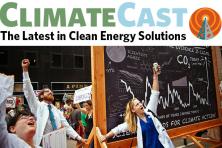Clean energy: great for the planet, great for businessMoney talks, and recent corporate investments reveal an emerging consensus: clean energy is a good business investment, while oil is becoming a riskier one. On the heels of President Trump’s announcement of plans to exit the Paris Agreement, Apple announced a new billion-dollar investment in “green bonds” to finance clean energy projects, from wind and solar to energy-efficient buildings. Investors bought $81 billion in green bonds in 2016; that total could reach $150 billion this year. Conversely, shale oil financiers recently pulled back on those investments, citing tumbling prices. At least some major oil producers now acknowledge that they must account for cost of climate pollution.. Exxon Mobil, BP and Royal Dutch Shell are among a group of corporations publicly support putting a price on carbon pollution.More industries also perceive the economic benefits of accounting for carbon. Rice growers in Arkansas, Mississippi and California recently cut methane emissions to open the agriculture industry’s participation in carbon markets. The first buyer of these offsets? Microsoft. Solar and wind are a clean, green grid-strengthening machineThis past spring, for the first time ever, wind and solar accounted for 10 percent of U.S. nationwide electricity generation. This fact, along with new research showing that countries with the most wind and solar have 10 times fewer outages than the U.S., demonstrates that clean energy is plentiful, cost effective, and just plain smart. California’s solar production was so high recently that the state was able to give neighboring Arizona 14 days’ worth of free power. A new report finds that renewable energy helps increase grid reliability by increasing the diversity of the electric system and another study found renewables pose no threat to power reliability. It’s no surprise then that national business groups representing renewable energy technologies have come together to share a mutual vision for the 21st century power grid: one that offers mutual support for the integration of clean power sources in the national power grid. And as clean energy implementation occurs across the country, clean energy innovation continues in the laboratory: researchers have recently discovered a way to generate solar energy from paint, while others project that the world could one day see wind turbines higher than the Empire State Building.The Pacific Northwest continues to leadDespite recent press on SolarWorld’s near collapse, Oregon’s solar industry continues to thrive. More Oregon business leaders also see the threat and economic opportunity presented by climate change, and recently banded together to present a unified voice in support of carbon pricing through forming the Oregon Business for Climate. But Pacific Northwest climate leadership doesn’t end there -- the City of Seattle just voted to uphold the Paris Climate Agreement. Leadership is also taking the form of pushing back against bad policy; a number of economists and other analysts have spoken out against President Trump’s proposal to sell much of the Northwest’s grid to a private buyer, sharing their opinion that such a move would greatly increase rates.Rising temperatures and hot impactsSummer is barely here and already bringing record-breaking temperatures and their impacts. The Guardian recently reported on seven climate change hotspots most impacted by heat and drought, while another National Geographic report concluded that by 2100, heatwaves could threaten a majority of the world’s people, beginning with those in developing nations. Oregon public health authorities are preparing to test local mosquitos for Zika virus—an illness seldom imagined likely to reach the Pacific Northwest, while Steelhead salmon counts plummet in the Santiam and Willamette Rivers. In Phoenix, it was so hot that planes couldn’t fly and residents saw record surges in power demand because of the heat.New administration to climate science: no thanksThe Federal government’s hostility to climate science continues to provoke opposition from across the country—from this spring’s climate-focused marches, to cities across the country re-publishing climate data stripped from the EPA website. Just last week the EPA leadership informed members of its Board of Scientific Counselors that their tenure would not be renewed, and the Energy Department closed its one office working on climate change abroad.The climate change movement faces need for adaptationAs climate impacts continue to worsen, popular movements to advance clean energy and fight climate change must grow and adapt to be just and effective. That’s why movement leaders are sharing calls to ensure that the climate movement includes everyone, from communities of color, to youth, immigrants and other affected communities. A recent opinion piece in The Oregonian urged Oregonians to stand strong against anti-immigrant attacks, noting that, as the climate crisis worsens, more people will be torn from their communities and that U.S. must welcome them. In The Statesman Journal, NAACP leaders urged local environmentalists to include people of color and low-income people in determining climate solutions that would benefit their communities. And finally, a discussion between lawmakers and youth in Portland highlighted the need to include all affected voices in the climate fight -- including those who may not be old enough to vote, but who will most certainly be impacted by the legislative actions taken (or not taken) today to address climate change.Despite attempts to derail and dismantle, Clean Fuels are workingWe see success among low-carbon fuel standards elsewhere; a new progress report on California’s clean fuels program showed fuel suppliers reporting 100 percent compliance in 2016, as well as exceeding their overall targets by approximately 60 percent since the program first started. Over 100 companies are actively participating in Oregon’s Clean Fuels Standard, yet the program remains threatened as a bargaining chip while the Oregon Legislature negotiates terms of a statewide transportation package. Biodiesel producer, Sequential, submitted an opinion piece urging support of the program, which has allowed them to hire 150 employees since it went into effect last year. Our own David Vant’Hof wrote to Climate Solutions supporters urging them to help protect one of Oregon’s signature clean air laws in the last few weeks of the legslative session.In BriefOne scientist is responding to federal environmental rollbacks by deciding to run for Congress herself. “The cure is more scientists who hold political office,” says Vulcanologist Jess Phoenix, who is running for Congress in California's 25th District:Image: A sunrise from the International Space Station. Note to readers: There’s something new about this issue of ClimateCast: it’s our first voyage with new editor Devon Downeysmith. A resident of Portland, Devon is an experienced communicator on climate and clean energy issues. With her at the wheel, we’re confident that you will continue to find inspiring and surprising coverage here every other week. If you like what you’re reading in ClimateCast, please let us know--and please forward to a friend! |
Image

NASA
Clean energy strengthens power grids, prosperity, people and the planet




